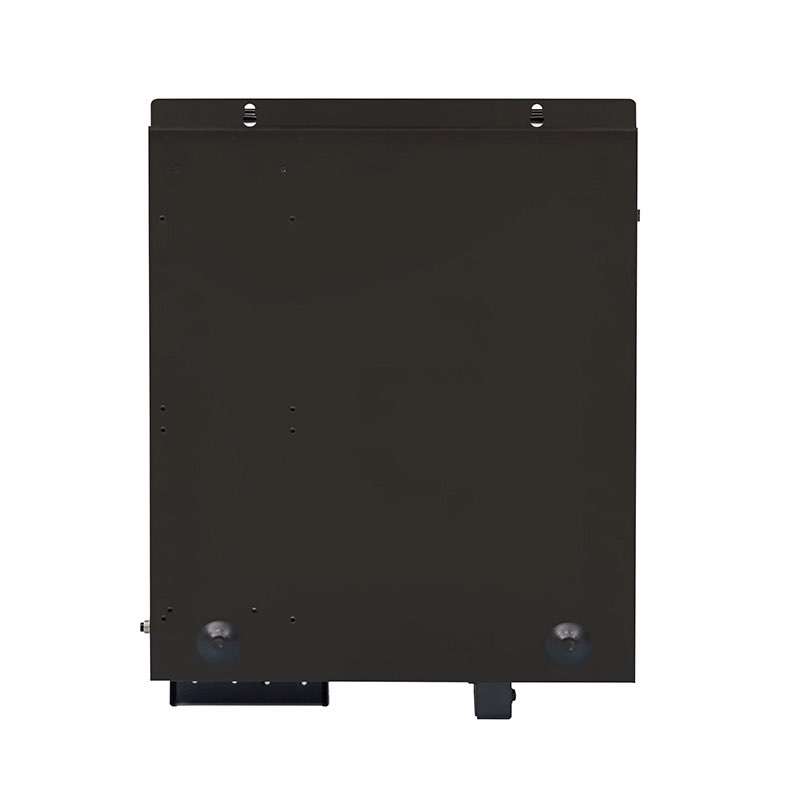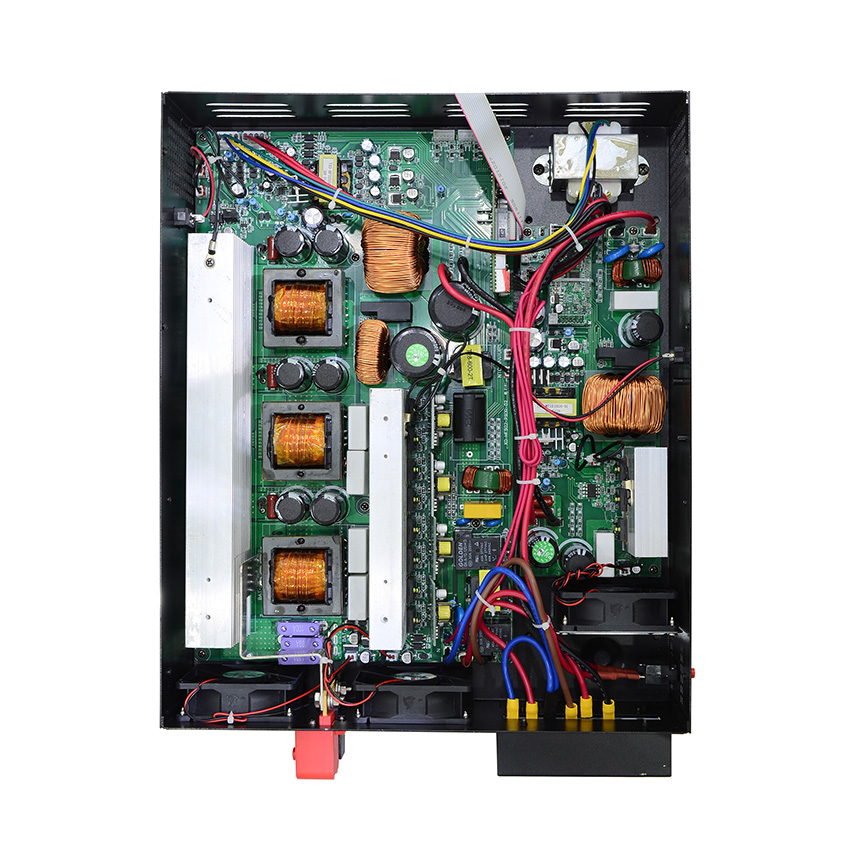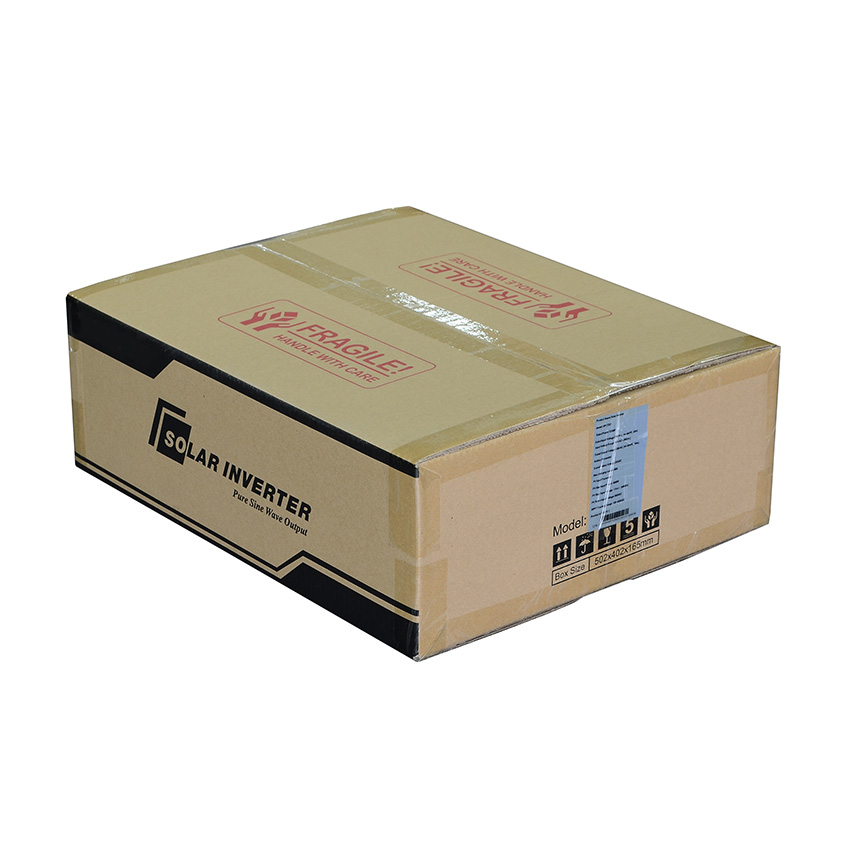
■ Hybrid Solar Inverter Feature
1 Inverter high frequency design, high power density, high efficiency, low no-load loss.
2 Hybrid inverter with built-in MPPT or PWM solar charge controller optional.
3 Pure sine wave output,any types of loads adaptable.
4 Battery charge and discharge voltage parameters adjustable,suitable for different types of batteries,can prolong the life of the battery and improve system performance.
5 AC charge current 0~60A adjustable,battery capacity configuration more flexible.
6 Three working modes adjustable:AC first,Battery first,PV first.
7 Output voltage/frequency adjustable function,adapt to different grid environment.
8 Extra wide voltage and frequency input range, support mains or generator.
9 LED+LCD display, easy operation and data checking,can set each function and data directly.
10 Multi-protection function(overload,over temperature,short circuit protection and so on).
11 RS485 communication port/APP (WIFI or GPRS) optional.
■ Hybrid Solar Inverter Specification
| Specification | ||||
| Model: HP-T | 32224 | 50248 | ||
| Rated Power | 3200W | 5000W | ||
| Peak Power(20ms) | 9600VA | 15KVA | ||
| Battery Voltage | 24VDC | 48VDC | ||
| Product Size(L*W*Hmm) | 476x350x118 | |||
| Package Size(L*W*Hmm) | 502x402x165 | |||
| N.W(Kg) | 11.5 | 11.8 | ||
| G.W(Kg) | 12.5 | 12.8 | ||
| Installation Method | Wall-Mounted | |||
|
Inside
MPPT
Solar
controller
(Optional)
|
Charging Mode | MPPT | ||
| Rated PV input voltage | 360VDC | |||
| MPPT tracking voltage range | 120V-450V | |||
|
Max PV Input Voltage Voc
(At the lowest temperature)
|
500V | |||
| PV Array Maximum Power | 4000W | |||
| MPPT tracking channels (input channels) | 1 | |||
|
Inside
PWM
Solar
controller
(Optional)
|
Charging Mode | PWM | ||
| Charging current | 60A/120A | |||
| PV Input Voltage Range | 30V-44V | 60V-88V | ||
|
Max PV Input Voltage Voc
(At the lowest temperature)
|
50V | 100V | ||
| PV Array Maximum Power | 1680W/3360W | 3360W/6720W | ||
| PV input channels | 1 or 2 | |||
| Input | DC Input Voltage Range | 21VDC-30VDC | 42VDC-60VDC | |
| Rated AC input voltage | 220VAC / 230VAC / 240VAC | |||
| AC Input Voltage Range | 170VAC~280VAC (UPS mode)/ 120VAC~280VAC(INV mode) | |||
| AC Input Frequency Range | 45Hz~55Hz(50Hz),55Hz~65Hz(60Hz) | |||
| Output | Output efficiency(Battery/PV Mode) | 94%(Peak value) | ||
| Output Voltage(Battery/PV Mode) | 220VAC±2% / 230VAC±2% / 240VAC±2% | |||
| Output Frequency(Battery/PV Mode) | 50Hz±0.5 or 60Hz±0.5 | |||
| Output Wave(Battery/PV Mode) | Pure Sine Wave | |||
| Efficiency(AC Mode) | >99% | |||
| Output Voltage(AC Mode) | Follow input | |||
| Output Frequency(AC Mode) | Follow input | |||
|
Output waveform distortion
Battery/PV Mode)
|
≤3%(Linear load) | |||
| No load loss(Battery Mode) | ≤1% rated power | |||
| No load loss(AC Mode) | ≤1% rated power(charger does not work in AC mode) | |||
| Battery |
Battery
Type
|
VRLA Battery | Charge Voltage :13.8V; Float Voltage:13.7V(Single battery voltage) | |
| Customize battery |
Charging and discharging parameters of different types of batteries can be customized according to user requirements
(charging and discharging parameters of different types of batteries can be set through the operation panel)
|
|||
| Maximum charging current (Mains or PV or mains + PV)(Built-in MPPT controller model) | 60A | 50A | ||
|
Maximum charging current
(Built-in PWM controller model)
|
Mains60A+
PWM controller charging current
|
Mains50A+
PWM controller charging current
|
||
| Charging method | Three-stage (constant current, constant voltage, floating charge) | |||
| Protection | Battery low voltage alarm | Battery undervoltage protection value+0.5V(Single battery voltage) | ||
| Battery low voltage protection | Factory default: 10.5V(Single battery voltage) | |||
| Battery over voltage alarm | Constant charge voltage+0.8V(Single battery voltage) | |||
| Battery over voltage protection | Factory default: 17V(Single battery voltage) | |||
| Battery over voltage recovery voltage | Battery overvoltage protection value-1V(Single battery voltage) | |||
| Overload power protection | Automatic protection (battery mode), circuit breaker or insurance (AC mode) | |||
| Inverter output short circuit protection | Automatic protection (battery mode), circuit breaker or insurance (AC mode) | |||
| Temperature protection | >90°C(Shut down output) | |||
| Working Mode | Mains priority/Solar priority/Battery priority(Can be set) | |||
| Transfer Time | ≤4ms | |||
| Display | LCD+LED | |||
| Thermal method | Cooling fan in intelligent control | |||
| Communication(Optional) | RS485/APP(WIFI monitoring or GPRS monitoring) | |||
| Environment | Operating temperature | -10℃~40℃ | ||
| Storage temperature | -15℃~60℃ | |||
| Noise | ≤55dB | |||
| Elevation | 2000m(More than derating) | |||
| Humidity | 0%~95% (No condensation) | |||
| Note:
1. The working mode of the built-in MPPT controller model supports PV priority/battery priority/mains priority, and the working mode of the built-in PWM controller model only supports battery priority/mains priority; 2. All specifications are subject to charge without prior notice.
|
||||
■ Hybrid Solar Inverter Details


■ Hybrid Solar Inverter Wiring Diagram
We offer 3 optional working modes for hybrid solar inverter (transfer time≤4ms):
1) AC priority mode (d0)
A. When the mains power is normal (in line with the inverter power input voltage range), on the one hand, the mains power charges the battery (if built-in solar controller, the mains power and solar energy charge the battery at the same time); on the other hand, only the mains power supplies power to the load (the load does not consume solar and battery energy);
B. When the mains power is abnormal (the mains power is beyond the working range of the inverter or the mains power is interrupted), the inverter will switch to the battery mode, and the battery will supply power to the load (if built-in solar controller, when the solar power is greater than the load power, the load will be completely supplied by the solar energy, and the excess energy will charge the battery; when the solar energy is less than the load power, the insufficient part will be supplemented by the battery. The load is supplied by solar energy and battery together).
2) PV priority mode (d1)
A. When the solar is normal (in line with the solar input voltage range of the inverter), if the solar power is greater than the power of the load, the load is completely powered by solar, and the solar excess enengy charges the battery, when the solar power is less than the power of the load, the insufficient part is supplemented by the battery, and the solar and the battery supply power to the load together. If the battery is low volage due to the load, then the inverter will turn to the AC mode for power supply, and the solar will only charge the battery;
B. When the solar is abormal (the solar volage exceeds the working range of the inverter or the solar is interrupted, the inverter will directly switch to the AC mode for power supply, and the mains power will charge the battery.
3) Battery priority mode (d2)
A. When the inverter has no low-voltage battery alarm, even if the mains power input is normal, the inverter will switch to the battery mode, and the battery will supply power to the load. When the solar power is greater than the load power, the solar power will supply power to the load completely. and the excess enengy will charge the battery. When the solar power is less than the load power, the insufficient part will be supplemented by the battery, and the solar and battery will supply power to the load together;
B. When the battery is low voltage (i.e. the voltage of a conventional single battery is 11vdc) and the mains power input is normal, the inverter will switch to the AC mode and the mains power will supply power to the load completely, while the solar energy will charge the battery but the mains power does not charge the battery.
■ Inverter Package and Delivery










